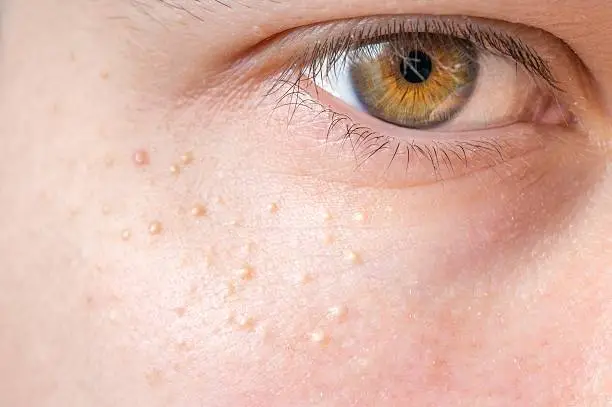What is Milialar?
Milialar are small, white or yellowish bumps that typically appear on the skin. They are often mistaken for whiteheads or pimples but have a different underlying cause. These tiny cysts form when keratin becomes trapped beneath the surface of the skin, creating a small bump that is difficult to extract.
Table of Contents
ToggleThese bumps can occur anywhere on the body but are most common around the eyes, cheeks, and nose. Milia are usually painless and do not pose any serious health risks; however, they can be unsightly and bothersome to some individuals.
While Milia can affect people of all ages, they are particularly common in newborns due to their underdeveloped sweat glands. In adults, factors such as sun damage, heavy skincare products, or genetic predisposition can contribute to their formation.
Understanding what Milia are is essential in determining how best to treat and prevent them from recurring on the skin.
What Causes Milialar?
Milialar occurs when dead skin cells get trapped and form small, white bumps on the skin. The exact cause of Milialar can vary, but commonly it’s due to an excess buildup of keratin under the skin’s surface. Factors like genetics, skincare products that are too heavy or oily, hormonal changes, or even certain medications can contribute to the development of Milialar.
Poor exfoliation can also play a role in Milialar formation as it prevents dead skin cells from shedding properly. Additionally, using harsh scrubs or not moisturizing enough can disrupt the skin’s natural balance and lead to these pesky bumps making an appearance.
It’s essential to understand what triggers your Milia flare-ups so you can take steps to prevent them in the future. By identifying the root cause and making necessary adjustments to your skincare routine, you can effectively manage and reduce the occurrence of Milialar on your skin.
The Different Types of Milialar
Milialar can present in various forms on the skin, each with its unique characteristics. The most common type is known as primary milia, which appears as small white bumps typically on the face. These tiny cysts form when dead skin cells get trapped beneath the surface of the skin.
Secondary milia, on the other hand, can develop due to conditions like blistering injuries or certain types of skincare products. They may appear in clusters and are often more challenging to treat compared to primary milia.
There’s also Neonatal milia that affects newborn babies and usually disappears on its own within a few weeks. Unlike primary and secondary milia, neonatal milia doesn’t require treatment unless it persists for an extended period.
Understanding these different types of milia can help you identify them accurately and seek appropriate remedies for clearer skin.
How to Identify Milialar on the Skin
Milialar, those tiny white bumps that can appear on your skin, may seem harmless at first glance. But identifying them correctly is crucial for effective treatment. These bumps are often mistaken for acne but have distinct characteristics.
To identify milialar on the skin, look for small, white or flesh-colored bumps that typically appear around the eyes, cheeks, and forehead. Unlike acne pimples, they don’t have redness or inflammation surrounding them.
When you gently press on a milialar bump with clean fingers or a cotton swab, it won’t pop like a pimple would. Instead, these bumps feel hard to the touch as they are trapped keratin beneath the skin’s surface.
If you notice these stubborn little bumps lingering on your skin despite regular cleansing and exfoliation routines aimed at treating acne, chances are you might be dealing with milia.
Consulting a dermatologist for proper diagnosis and treatment options is advisable if you suspect milia forming on your skin to avoid further irritation or complications in managing this condition effectively.
Natural Remedies for Milialar
When it comes to dealing with Milialar naturally, there are several remedies you can try at home. One popular option is using gentle exfoliants like sugar scrubs or oatmeal masks to help remove dead skin cells that may be clogging pores and contributing to Milialar.
Another natural remedy is applying tea tree oil, known for its antibacterial properties, directly on the affected areas. Aloe vera gel is also a soothing option that can help reduce inflammation and redness associated with Milialar.
Additionally, incorporating probiotics into your diet or taking supplements may help promote healthy gut bacteria, which could in turn improve skin health and reduce the occurrence of Milialar. Drinking plenty of water and maintaining a balanced diet rich in fruits and vegetables can also support overall skin health from the inside out.
Remember to always patch test any new natural remedies before applying them widely to ensure they don’t cause irritation or allergic reactions on your skin.
Medical Treatments for Milialar
If natural remedies don’t provide the desired results, medical treatments for milialar can offer effective solutions. Dermatologists may recommend procedures like extraction or de-roofing to physically remove the milia cysts. These methods involve using sterile tools to carefully extract the trapped keratin beneath the skin’s surface.
Another common medical treatment is chemical peels, which use acids to exfoliate and unclog pores, helping to eliminate milia. In some cases, dermatologists may suggest laser therapy to target and destroy milia cysts. This non-invasive procedure can be particularly beneficial for stubborn or recurrent milialar.
Prescription medications such as retinoids or topical antibiotics may also be prescribed by healthcare professionals to help reduce inflammation and prevent future milia formation. It’s essential to consult a qualified dermatologist before undergoing any medical treatment for milialar.
Tips for Preventing Milialar
One effective way to prevent Milialar is by maintaining a consistent skincare routine. Cleansing your face twice daily with a gentle cleanser helps remove impurities that can contribute to Milialar formation. Exfoliating regularly can also help prevent the buildup of dead skin cells that may clog pores and lead to Milialar.
Using non-comedogenic or oil-free moisturizers and makeup products can reduce the risk of pore blockages. It’s important to choose products specifically formulated for your skin type to avoid exacerbating Milialar.
Protecting your skin from excessive sun exposure by wearing sunscreen daily can also aid in preventing Milialar. Sun damage can worsen existing skin issues, including Milialar, so it’s crucial to shield your skin from harmful UV rays.
Maintaining a healthy diet rich in fruits, vegetables, and water promotes overall skin health and may help prevent conditions like Milialar. Additionally, avoiding touching your face frequently with unwashed hands can reduce the transfer of bacteria and dirt that could trigger Milialar outbreaks.
Conclusion
Understanding what milia are and how to treat them is essential for maintaining healthy skin. By identifying the causes, types, and symptoms of milia, you can take proactive steps to eliminate these pesky bumps. Whether opting for natural remedies or seeking medical treatments, there are effective ways to manage milia and prevent their recurrence. Remember to practice good skincare habits and consult a dermatologist if needed in order to keep your skin clear and smooth. With the right approach, you can say goodbye to milia for good!



